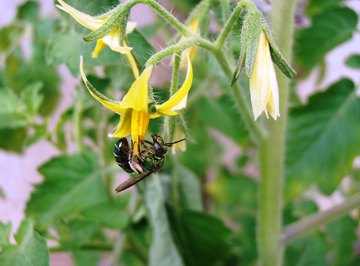
Wasps, hornets and bees are stinging insects that are frequently confused. Although similar in appearance, each of these insect species has distinct features and behaviors that makes it unique from the others. Bees are easier to spot once you realize that their yellow-and-black bodies have a covering of fine hairs. The differences between the wasp and hornet are less obvious.
Bee, Wasp and Hornet Classification
Bees and wasps are members of the order Hymenoptera, a large and diverse group of species that typically live in groups or colonies. Insects in this order have two pairs of clear wings and mouthparts that are adapted for chewing. When comparing wasp vs. bee, there are some big differences. Bees consume pollen and nectar and are pollinators of flowering plants. Wasps are attracted by sweet foods like fruit and juices, but they don’t perform any kind of pollinating function. Many wasp species are predators that eat other insects like caterpillars, beetles and spiders.
The name “hornet” is given to the largest type of wasps. Allong with yellowjackets, they are part of the scientific family Vespidae. Besides being larger in size, insects in the Vespidae family have more aggressive behavior. Wasps and hornets will use their stingers to repeatedly attack when their nests are threatened.
Wasp vs. Bee Stinger
Although people usually blame bees for insect stings, it’s far more likely that a sting is caused by a yellowjacket. Honey bees, which have barbed stingers, die after stinging because they can't recover from damage to their abdomen when the stinger is left behind in their victim. Wasps and hornets are able to sting many times with their smooth stingers. People should avoid yellowjackets and other wasps that are showing signs of aggression because being repeatedly stung can be very harmful, especially for those who are allergic to wasp venom.
Wasp Versus Hornet Appearance
Both wasps and hornets can be dangerous when they build their nests near humans because the insects will become aggressive and attack when their nests seem to be under threat. Unlike bees, both insects have stingers that can be retracted and used more than once. Despite these similarities, there are certain physical features that can help tell the difference between a wasp and a hornet. Wasps are smaller in size and colored red, black or yellow. Hornets are 1/2 inch to 2 inches in length and vary in color from black and brown to slightly reddish.
Behavior of Hornet vs. Wasp
Besides differences in appearance, you can often tell hornets from wasps based on their behavior. Hornets build nests off the ground or high up in the leaves of trees. They cover the insides of their nests with a paper-like substance made from chewed-up plant material and saliva paste. Hornet nests can be several inches or several feet in diameter. Although yellowjackets can be very aggressive when provoked, most types of hornets are docile and only show defensive behavior when their nests are threatened.
Wasps will build nests in the air, on the ground or even in underground burrows. They do not protect the interior of their nests the way hornets do. The paper wasp, which is common throughout North America, constructs an open, cone-shaped nest in piles of twigs or in shrubs or trees as well as under the eaves and in the rafters of houses. The nests are formed from chewed up materials into a structure that resembles gray papier mache. If you come upon an occupied paper wasp nest, it’s best to avoid it or have it removed by professionals. Unlike honey bees, which will return to the same hive year after year, a wasp or hornet nest will be abandoned during winter and never reoccupied.
References
About the Author
Catie Watson has a degree in Computer Science and spent 30 years working as a software engineer for Disney, Unisys and Siemens. She writes about science and technology online and in print publications and was a contributor to the textbook series “Computers, Internet and Society.”
